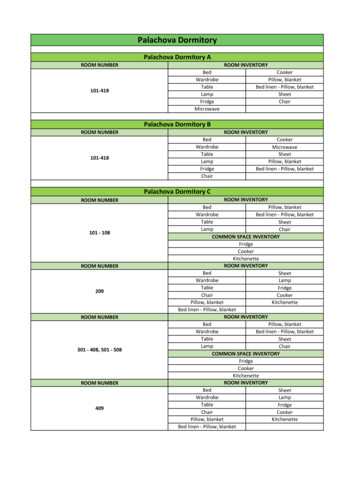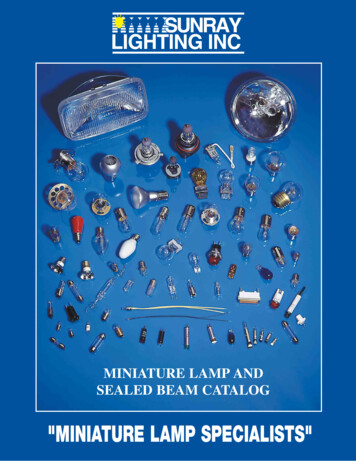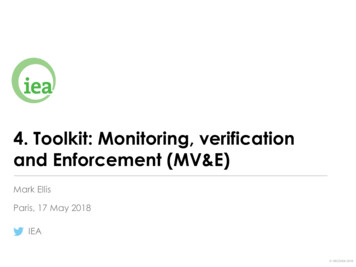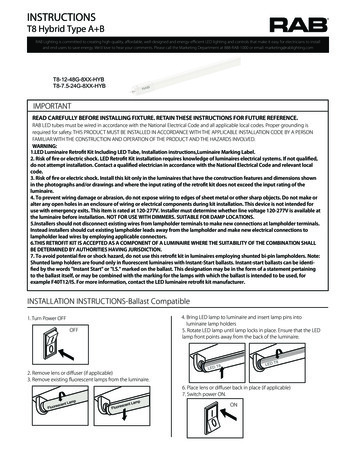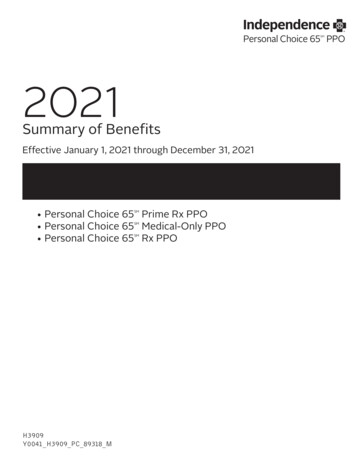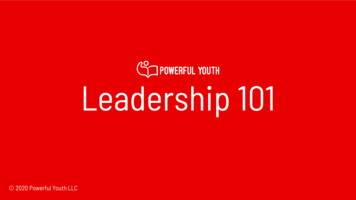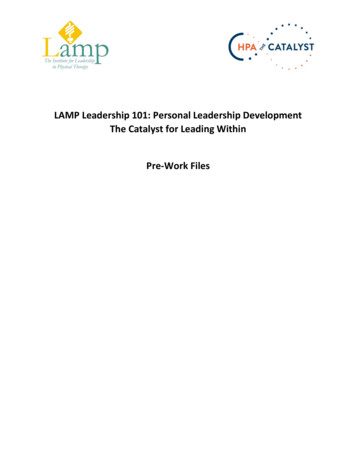
Transcription
LAMP Leadership 101: Personal Leadership DevelopmentThe Catalyst for Leading WithinPre-Work Files
LAMP Leadership 101: Pre-Conference WorkReadings and ReflectionLAMP Leadership 101 Pre-Work: The faculty of the LAMP program have selected readings and exercisesto prepare you for the conference, as well as to start developing a personal leadership developmentplan. Please allow yourself sufficient time to complete the reading, reflection, and your leadership selfassessment. Please expect to allocate about four (4) hours of total time complete the pre-workassignments.Readings: Please read the following articles:George, B., et al. (2007). Discovering your authentic leadership. Harvard Business Review, (85)2, 129138.Zaleznik, A. (1977/2004). Managers and leaders: are they different? Harvard Business Review, 82(1), 7481.Self-AssessmentObjectives: After completing the readings and self-assessment, the participant will be able to: Recognize the importance of self-assessment in leadership development; Complete a self-assessment of his/her leadership abilities and behaviors to identify personal,interpersonal, organizational and community leadership goals; and Use the self-assessment and information gained at LAMP Leadership 101 to generate anindividualized personal leadership development plan following LAMP Leadership 101.Leadership Self- Assessment: Allow yourself at least 1 – 2 hours to complete this self-assessment (startearly!). Complete the Leadership Self-Assessment by assessing your current skills and abilities in fourareas: personal, interpersonal, group/organizational and community. After you complete pages 1- 4, usethe tables on pages 5-9 to summarize your areas of strengths and weaknesses, and to begin to developgoals for your personal development.Thomas-Kilmann Conflict Mode Instrument:In addition, please complete the TKI (Thomas-Kilmann Conflict Mode Instrument) questionnaire andbring it with you to the course. You will be provided on-site with the full kit for scoring the instrumentand the related interpretation materials.Emotional Intelligence QuestionnairePlease complete this and we will be going over the results on-site.Practice Act and Code of ConductPlease bring your profession’s state practice act, rules and regulations and the professional association’scode of ethics (or ethical conduct) with you. These will be useful during the Ethics and Leadershipinteractive lab session.1
Section on Health Policy & AdministrationLAMP – Leadership Development Self-Assessment1The Leadership Development Self-Assessment tool was developed by the LAMP Institute for Leadership inPhysical Therapy of the Section on Health Policy and Administration of the American Physical TherapyAssociation.The assessment is required pre-work for the two-day comprehensive program – LAMP Leadership 101:Personal Leadership Development: The Catalyst for Leading Within. This program is the first component of theLAMP Institute. For more information regarding the LAMP Institute, please visit the website at:www.lampinstitute.orgInstructionsThis assessment is composed of four components dealing with personal leadership development,interpersonal leadership development, group/organizational leadership development, and communityleadership development. There is a set of 20 statements that reflect various attributes and skills for eachcomponent.Please read each statement carefully. Then rate yourself in terms of how well you think you possess theattribute or perform the leadership skill. This is not a test. There is no right or wrong answer. Please respond toevery statement. In selecting your response, be realistic and honest with yourself. Do not answer in terms ofhow you would like to see yourself, in terms of what you should be doing, or in terms of how you think othersview you. Instead, respond as honestly as possible.The assessment provides three choices: I do not do this skill wellI do this skill somewhat wellI do this skill wellThen, go back and place a check in the box at the end of the row of the skills you genuinely want to develop.Please consider the skills you do not do well and what you might do to improve them. This is where you arelikely to grow the most. Think about stretching yourself 10 percent.The Leadership Development Self-Assessment is found on the following pages, 1 - 4. Instructions on how touse the information start on page 5. On pages 5 – 9, you will summarize your strengths and weakness(es) ineach area of leadership then develop goals that will guide you in developing your Leadership PersonalDevelopment Plan. Remember, this assessment is for your benefit in thinking about the goals you want toestablish for this program and ways in which you can grow the most.1This instrument was adapted from the tool developed for the College of Agriculture Leadership Development Certificate Program byJanet S. Ayres, Professor, Leadership Development, Department of Agricultural Economics, Purdue UniversityAuthor granted permission to use the tool for the LAMP Institute of the Section on Health Policy & Administration - APTA2
Leadership Development Self-AssessmentPart 1 of 4Do NotDoWellPersonal Leadership DevelopmentDoSomewhatWellDoWellUnderstands Leadership1.I am aware of my leadership strengths and weaknesses.2.I take initiative on projects.3.I build relationships with others in order to reach a mutual goal.4.I understand the underlying concepts of leadership.5.I adapt my leadership style to different situations.6.I have a personal philosophy of leadership.Awareness of Self7.I am aware of my attitudes, values, biases and prejudices.8.I engage in activities that build or improve my leadershipabilities.9.I pay attention to how my language and behavior may beperceived by others.10.I am able to exert self-discipline and control over my behavior.11.I know my personal power to make a difference in my life andothers.Practices Ethical Behavior12.I understand the ethical responsibilities that come withleadership.13.I follow through on commitments I make.14.I am trustworthy.15.I act in accordance with my words, e.g., “walk the talk”16.I lead by setting a positive example for others.Sustains Leadership17.I am a life-long learner.18.I reflect on situations and learn from them.19.I am resilient, when things don’t work out, I learn from it andbounce back.20.I provide opportunities for others to be leaders.Leadership Development Self-Assessment(c) LAMP Institute of the Section on Health Policy & Administration - APTA3Want toDevelop
Leadership Development Self-AssessmentPart 2 of 4Do NotDo WellInterpersonal Leadership DevelopmentDoSomewhatWellDoWellValues Diversity1.I value that each person is different.2.I treat each person with respect.3.I work effectively with others who are different from me.4.I reach out to include other people.Enhances Communication Skills5.I listen carefully to understand what another person is saying.6.To avoid misunderstanding, I ask questions to clarify what theother person is saying.7.I say what I mean and mean what I say.8.When I speak, my message is clear.9.When I have a good reason for doing so, I can express a view thatdiffers from that of others.10. To get different perspectives, I ask for input from a wide range ofpeople.11. I establish rapport with people.12. I influence others through what I say and how I say it.13. I seek feedback from others, even if it might be negative.14. If my work affects others, I keep them informed about what I’mdoing.15. I work at building a network of resource people.16. I initiate relationships with others.Manages Conflict17. I work to solve problems, not blame others, when we hit a stonewall.18. I am able to give constructive negative feedback to others whenneeded.19. I initiate successful resolution of conflict with others.20. I can manage conflict to create positive opportunities.Leadership Development Self-Assessment(c) LAMP Institute of the Section on Health Policy & Administration - APTA4Want toDevelop
Leadership Development Self-AssessmentPart 3 of 4Group and Organizational Leadership DevelopmentDo NotDo WellDoSomewhatWellDoWellDevelops Teams1.I value the contribution each person makes to a team.2.I help a group identify a common goal.3.When working in a team situation, I help the group keep itsfocus.When in a team, I help ensure that everyone is kept informedand that information is freely shared.When I’m responsible for a task or project, I follow through in atimely way.I work well with others on a team.4.5.6.7.When in a team, I help the team determine how it will worktogether as a team.Leads Change8.I take on new challenges in a group or organization.9.I initiate new projects with a group/organization.10.11.I see opportunities in challenges faced by a group/organizationand help them move forward.I help groups/organization develop a vision for its future.12.I initiate strategic planning processes with groups/organizations.Manages Projects15.I understand the difference between the functions of leadershipand management in an organization.I understand the dynamics of groups and adjust my leadershipstyle accordingly.I help groups make decisions through consensus.16.I match the various skills and interests of people to the tasks.17.I help groups set priorities and develop a plan of action.18.I help groups find resources to implement their plan of action.19.I ensure that everyone is kept informed and involved in groupprojects.I give recognition to people who have done the work.13.14.20.Leadership Development Self-Assessment(c) LAMP Institute of the Section on Health Policy & Administration - APTA5Want toDevelop
Leadership Development Self-AssessmentPart 4 of 4Do NotDo WellCommunity Leadership Development1.2.3.4.DoSomewhatWellDoWellPractices CitizenshipI vote in every election.I stay current with issues at the local, state, national and worldlevel.I get involved in my community because I know that in ademocracy I must do part.I understand the responsibilities for living in a democracy.Understands Community Complexity6.I understand the complexity of communities (education,economics, natural resources, infrastructure, people,government, etc.)I try to make a difference in my community.7.I understand the role of government and public policy making.8.I understand the role of non-profits in a community.9.I understand who the decision makers are in the community andhow public decisions are made.I understand the important role played by the news media in ademocracy.I participate in public meetings where important issues are beingdiscussed.I understand the importance of building partnerships in acommunity to get things done.I understand social injustice, prejudices and biases in our societyand work to eliminate them.5.10.11.12.13.Committed to Serving Others15.I try to make a difference for causes that are greater than myown needs.I volunteer to serve others in the community.16.I engage with culturally different groups in the community.17.I reflect on my community service to learn more about myself.18.I help people in a community organize to undertake aworthwhile project.I help people in a community who do not have a voice at thepolicy table develop a way to be heard.I help bring information or other resources to a communityproject.14.19.20.Leadership Development Self-Assessment(c) LAMP Institute of the Section on Health Policy & Administration - APTA6Want toDevelop
How Do I Use the Leadership DevelopmentSelf-Assessment?The purpose of this self-assessment tool is to help you think about the many skills andattributes of leadership, the ones you already possess, and the ones you would like to develop.There is no way that any one person can master all of these, even in a lifetime. For thepurposes of the LAMP Leadership Development Program, this instrument is intended to helpyou assess your strengths and weaknesses, why you think you are strong or weak in theseattributes, and identify areas in which you wish to develop. From this assessment, you shouldbe able to develop your goals for your Personal Development Plan.First, go through the assessment and think about the attributes and skills in regards to how wellyou perform them.Second, go through the assessment and consider which attributes and skills you would like togrow or develop. Although it is expected that over the course of this program you will developto some extent in all the skills and attributes, we suggest it is important to focus your attentionon four specific skills with an intentional plan on how you intend to grow or develop.The following questions are intended to assist you in analyzing your responses, reflecting onyour leadership abilities, and determining your goals for this program.Personal Leadership DevelopmentLooking back at Part 1 of your assessment, what are the four personal leadershipskills/attributes that you do best? Why do you do these well?Skill or attributeWhy do I do these well?1.2.3.4.Leadership Development Self-AssessmentAPTA(c) LAMP Institute of the Section on Health Policy & Administration -7
What are the four personal leadership skills/attributes that you do not do well? Why do you notdo these well?Skill or attributeWhy do I not do these well?1.2.3.4.What are the four personal leadership skills/attributes you have the most interest indeveloping?1.2.3.4.From this list, circle the one personal leadership skill/attribute that you would most like todevelop during this program.Interpersonal Leadership DevelopmentLooking back at Part 2 of your assessment, what are the four interpersonal leadershipskills/attributes that you do best? Why do you do these well?Skill or attributeWhy do I do these well?1.2.3.4.Leadership Development Self-AssessmentAPTA(c) LAMP Institute of the Section on Health Policy & Administration -8
What are the four interpersonal leadership skills/attributes that you do not do well? Why doyou not do these well?Skill or attributeWhy do I not do these well?1.2.3.4.What are the four interpersonal leadership skills/attributes you have the most interest indeveloping?1.2.3.4.From this list, circle the one interpersonal leadership skill/attribute that you would most liketo develop during this program.Group/Organizational Leadership DevelopmentReviewing Part 3 of the Leadership assessment, what are the four group/organizationalleadership skills/attributes that you do best? Why do you do these well?Skill or attributeWhy do I do these well?1.2.3.4.Leadership Development Self-AssessmentAPTA(c) LAMP Institute of the Section on Health Policy & Administration -9
What are the four group/organizational leadership skills/attributes do you not do well? Why doyou not do these well?Skill or attributeWhy do I not do these well?1.2.3.4.What are the four group/organizational leadership skills/attributes that you have the mostinterest in developing?1.2.3.4.From this list, circle the one group/organizational skill/attribute that you would most like todevelop during this program.Community Leadership DevelopmentLooking back at Part 4 of your assessment what are the four community leadershipskills/attributes that you do best? Why do you do these well?Skill or attributeWhy do I do these well?1.2.3.4.Leadership Development Self-AssessmentAPTA(c) LAMP Institute of the Section on Health Policy & Administration -10
What are the four community leadership skills/attributes do you not do well? Why do you not dothese well?Skill or attributeWhy do I not do these well?1.2.3.4.What are the four community leadership skills/attributes that you have the most interest indeveloping?1.2.3.4.From this list, circle the one community leadership skill/attribute that you would most like todevelop during this program.SummaryThe four leadership skills or attributes I would most like to develop during this program are:1.2.3.4.In your Personal Leadership Development Plan (PLDP), you will write goal statements for eachof these skills/attributes.Leadership Development Self-AssessmentAPTA(c) LAMP Institute of the Section on Health Policy & Administration -11
LAMP Personal Leadership Development PlanThe LAMP Personal Leadership Development Plan tool was developed by the LAMP Institute forLeadership in Physical Therapy of the Health Policy and Administration Section of the AmericanPhysical Therapy Association. The development of a personal plan is required followingparticipation in the two-day comprehensive program – LAMP Leadership 101: PersonalLeadership Development: The Catalyst for Leading Within. It is the pre-requisite forparticipating in LAMP Leadership 201: Advanced Leadership Development: The Catalyst forLeading Others. This program is the first component of the LAMP Institute. For moreinformation regarding the LAMP Institute, please visit the website at: www.lampinstitute.orgWhat is a Personal Leadership Development Plan?The Personal Leadership Development Plan, or PLDP, is a roadmap that will guide you throughcontinuous growth in four or more leadership skills and attributes. The PLDP is the foundation to aproductive start or continuation in developing your leadership skills and abilities. We suggest that thefollowing seven steps be followed. Similar to a road map, the PLDP serves as the participant guidethroughout the entire LAMP Leadership Development Certificate Program journey.How Do I Complete My Personal Leadership Development Plan?You will develop your personal development plan using the results of the Leadership Development SelfAssessment in conjunction with other resources and information gathered from LAMP Leadership 101.Feel free to be creative in how you develop your PLDP but make sure it contains the three main foci:1. Leadership Skill/Goal to be developed or accomplished2. Specific Mechanism by which the skill/goal will be developed or accomplished3. Anticipated Outcome(s) of the PLDP.It is recommended that a table format be used to develop your PLDP. The table should include threecolumns: Leadership Skills and Attributes (identified through the Leadership Development SelfAssessment) and Goal column, a Specific Mechanism column to describe how you plan to obtain eachskill and goal, and an Anticipated Outcome column to document how you will benefit from theexperience. A template for the table is provided at the end of this document.Here are the steps you need to take to complete your PLDP and the program.Step 1: Analyze Your Skills and AttributesYou have been provided a Leadership Development Self-Assessment in a separate document.Completing the self-assessment will assist you in thinking about the various aspects of leadership, yourstrengths and areas for growth. From this assessment, you can identify the skills or attributes you wishto grow, develop your goals, and ways to accomplish them.Personal Leadership Development Plan12 Section on Health Policy & Administration - APTA
Step 2: Develop Your Personal Intent StatementDevelop a statement that summarizes your goals for participating in a leadership development program.This Personal Intent Statement explains why you want to be in the program and what you hope to gainfrom it. For example, a statement might be:I want to be in the LAMP Leadership Program to gain more confidence in myself, to be a better teamleader, to be a better communicator and to make a difference in the organizations to which I belong.Step 3: Development of GoalsRefer back to the summary of your Leadership Development Self-Assessment on page 10. Develop agoal for each of the four leadership skills/attributes you would like to develop – one from each of thefour categories. Goals should be specific, measurable, acceptable by you, realistic, and accomplishableby a specific time. The goals will be placed in the first column of your PLDP.Step 4: Specific Ways to Reach GoalsNow that you have your goals, what activities will you do to achieve them? Examples of leadershipopportunities may include but are not limited to: Team Experiences in your organization or community,Mentoring Programs, Community Activities, Leadership Programs and Workshops, and AcademicCourses (should you decide to pursue this). The activities you choose should link directly with your goals.These activities should be placed in the second column, aligned with each goal.Step 5: Anticipated OutcomesWhat do you think will be the outcome from your participation in the proposed activity that will helpyou improve the leadership skill and attribute? Again, the activities you choose to do should provide themechanism to achieve your goals. These outcomes should be placed in the third column, aligned witheach goal and associated activity(s).Step 6: Finalize the PLDPOnce you have completed the Leadership Self-Assessment and attended LAMP Leadership 101,you may use the information presented and assessment tools provided to finalize your PLDPprior to registering for LAMP Leadership 201. You will have an opportunity to refine your PLDPand begin to formulate your personal leadership development project at LAMP 201.Step 7: Share your PLDP with a LAMP Leadership MentorAfter you have completed LAMP Leadership 101 and LAMP Leadership 201 and drafted your PLDP, youare now ready to register for LAMP 202: Leadership Practical Application at www.lampinstitute.org. Youwill be assigned a Leadership Mentor with whom you will review your PLDP to get started with yourpersonal project. It is also important that you review your plan with other people in your life.Personal Leadership Development Plan13 Section on Health Policy & Administration - APTA
When you are ready, set up a brief discussion with your LAMP Mentor (see www.aptahpa.org for moredetails) and be prepared to discuss the following: Your personal assessment results Your latest draft of your Personal Leadership Development Plan and reasons for choosing eachdevelopment objective How your Personal Leadership Development Plan ties into your LAMP-Leadership DevelopmentCertificate Program effort and which skills you are focusing on through your planOver time, you may have a number of conversations with your ‘coach’ and/or ‘mentor’ to discuss yourPLDP and associated project. The first one might be to discuss the results of your assessment, yourgoals, and possible activities to meet your goals. The second meeting might be to review the draft ofyour Personal Development Project.Please note: We will review these steps during the LAMP Leadership 101 Program.After you have refined your PLDP, complete the Personal Leadership Development Plan SubmissionForm on the next page and be prepared to go over it with your LAMP Mentor (‘coach’ and/or ‘LAMPLeadership Mentor’). Your mentor will need to sign the form. Submit your PLDP and completed PLDPSubmission Form to the LAMP Institute (see www.aptahpa.org for more details). Please note: allinformation will be kept confidential.Step 8: Review and Update the PLDPOngoing review of your Personal Leadership Development Plan is key to successful development. It isimportant to document this review and update your portfolio.It is important to monitor your progress and development through your portfolio. This is for tworeasons: To demonstrate to your LAMP Leadership Mentor that you have successfully completed thePersonal Leadership Development Plan portion as well as the Leadership Portfolio portion of therequirement; and To reflect on your progress and success in realizing the full potential of your Personal LeadershipDevelopment Plan.Personal Leadership Development Plan14 Section on Health Policy & Administration - APTA
Personal Leadership Development Plan Submission FormParticipant’s Name:LAMP Leadership Mentor’s Name:A. Personal Leadership Development Intent Statement:B. My goals, based upon the Skills and Attributes from the four Leadership DevelopmentalAreas, are:Personal:Interpersonal:Group:Community:C. The one or two Goals to be achieved through my Personal Leadership Development Projectare the following (select two from Section B onal Leadership Development Plan15 Section on Health Policy & Administration - APTA
D. The activities proposed to meet the Certificate of Completion Requirements are:o EXAMPLE: Participate in Worksite Experience(s): for goal for goalo EXAMPLE: Participate in Community Group Experience(s): for goal for goalo EXAMPLE: Participate in Leadership Programs and Workshops: for goal for goalo EXAMPLE: Other Leadership Development Activity: for goal for goalo EXAMPLE: Complete Academic Course Offerings: (completion of academic course workis NOT required. This is simply an example of what one may choose to do) for goal for goalE. Additional thoughts, suggestions, challenges, or concerns:Personal Leadership Development Plan16 Section on Health Policy & Administration - APTA
This Personal Leadership Development Plan meets the requirements of the LAMP Institute forthe Leadership Development Certificate:LAMP Mentor’s Signature:Personal Leadership Development PlanDate:17 Section on Health Policy & Administration - APTA
PERSONAL LEADERSHIP DEVELOPMENT PLAN – WORKSHEETLeadership Skill/Attribute GoalsSpecific Mechanism(How you will achieve the goal)1. Personal Leadership2. Interpersonal Leadership3. Group/Organization Leadership4. Community LeadershipPersonal Leadership Development Plan Section on Health Policy & Administration - APTA18Anticipated Outcome(What do you want to achieve?)
INSTRUCTIONSConsider situations in which you find your wishes differing from those of anotherperson. How do you usually respond in such situations?The following pages contain 30 pairs of statements describing possible behavioralresponses. For each pair, please circle the letter(" A" or "B") of the statement that bestcharacterizes your behavior.In many cases, neither the "A" nor the "B" statement may be very typical of yourbehavior; but please select the response you would be more likely to use.Tho' s-Kilmann Conflict Mode Instrument Copyright 1974, 2002, 2007 by CPP. Inc. This copyrighted publication is not offered for sale;it is for licensed use only. CPP reserves all rights beyond the limited scope of this license, including, without limitation, all rights under U.S.and international copyright and trademark laws. No portion of this publication may be reproduced, stored in a retrieval system. or trans mitted in any form or media or by any means, electronic, mechanical. photocopying, recording, or otherwise, without the prior writtenpermission of CPP. Inc. This copyrighted publication may not be resold, sublicensed, exported, redistributed, otherwise transferred, or usedin any manner by any party other than the person or entity to whom it is licensed for use by CPP. Inc.: any violation of any of these restric tions may infringe CPP's copyright under 17 U.S.C.§ 106(3), and any such violation shall automatically terminate any license to use this pub lication. The TKI and CPP logos are trademarks or registered trademarks of C PP, Inc., in the United States and other countries. Printed inthe United States of America.20 19 18 17 16 15 14 80 79 78 77 76 75 74 73 72 71 70 69 68 67 6619
THOMAS-KILMANN CONFLICT MODE INSTRUMENTI. A. There are times when I let others take responsibility for solvingthe problem.B. Rather than negotiate the things on which we disagree, I try tostress those things on which we both agree.2.A. I try to find a compromise solution.B. I attempt to deal with all of his/her and my concerns.3. A. I am usually firm in pursuing my goals.B. I might try to soothe the other's feelings and preserve our relationship.4.A. I try to find a compromise solution.B. I sometimes sacrifice my own wishes for the wishes of the other person.5. A. I consistently seek the other's help in working out a solution.B. I try to do what is necessary to avoid useless tensions.6.A. I try to avoid creating unpleasantness for myself.B. I try to win my position .7. A. I try to postpone the issue until I have had some time to think it over.B. I give up some points in exchange for others.8.A. I am usually firm in pursuing my goals.B. I attempt to get all concerns and issues immediately out in the open.9.A. I feel that differences are not always worth worrying about.8. I make some effort to get my way.1 O. A. I am firm in pursuing my goals.B. I try to find a compromise solution.20
11.A. I attempt to get all concerns and issues immediately out in the open.B. I might try to soothe the other's feelings and preserve our relationship.12.A. I sometimes avoid taking positions that would create controversy.B. I will let the other person have some of his/her positions if he/she lets mehave some of mine.13.A. I propose a middle ground.B. I press to get my points made.14.A. I tell the other person my ideas and ask for his/hers.B. I try to show the other person the logic and benefits of my position.15.A. I might try to soothe the other's feelings and preserve our relationship.8. I try to do what is necessary to avoid tensions.16.A. I try not to hurt the other's feelings.B. I try to convince the other person of the merits of my position.17.A. I am usually firm in pursuing my goals.B. I try to do what is necessary to avoid useless tensions.18.A. If it makes other people happy, I might let them maintain their views.B. I will let other people have some of their positions if they let me have someof mine.19.A. I attempt to get all concerns and issues immediately out in the open.B. I try to postpone the issue until I have had some time to think it over.20.A. I attempt to immediately work through our differences.B. I try to find a fair combination of gains and losses for both of us.21
21.A. In approaching negotiations, I try to be considerate of the other person's wishes.B. I always lean toward a direct discussion of the problem.22.A. I try to find a position that is intermediate between his/hers and mine.B. I assert my wishes.23.A. I am very often concerned with satisfying all our wishes.B. There are
LAMP Leadership 101 Pre-Work: The faculty of the LAMP program have selected readings and exercises to prepare you for the conference, as well as to start developing a personal leadership development plan. Please allow yourself sufficient time to complete the readin
